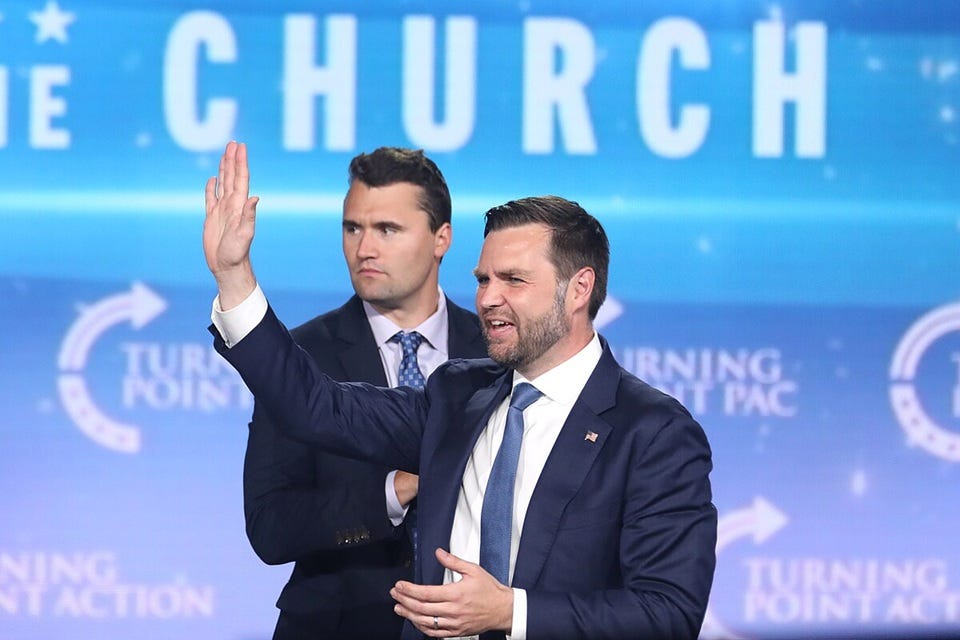Understanding America's New Right
Fighting for Western Civilization in someone else's back yard
“Now we are not outnumbered! Now WE have an army!” — Thorin
This post is going to be something a little different than usual. Most of my posts try to explain the facts of the world; today I’m going to try to explain an ideology.
You can’t really understand policymaking without ideology. This is something most commentators intuitively grasp, but many academics don’t. If you sold tax cuts in 1981 as “Keynesian demand stimulus”, you wouldn’t have gotten anywhere, but “supply-side” arguments won the day. Ideology is the way most leaders, advisors, and commentators organize their thinking about policy; it serves as a coordination mechanism to make sure that a bunch of people are basically on the same page about what they ought to do.
Here’s an example. In the recent Signal group-chat incident, JD Vance seemed obsessed with the idea of not helping Europe:
"I think we are making a mistake," Vance wrote in the Signal group with Cabinet secretaries and senior White House officials, arguing that the Houthis were more Europe's problem than America's…In the text messages, Vance said of the planned bombings: "I am not sure the president is aware how inconsistent this is with his message on Europe right now."
Why was not helping Europe even more important to the Vice President than accomplishing the operation’s actual military objectives? The only possible answer is “ideology”.
In fact, I’ve found myself using ideology as my explanation for much of what the Trump administration has done in the two months since it came to power. I explained Trump’s tariffs as an ideologically driven attempt to isolate America from foreign dependency and ape the country’s “glory days” of the pre-WW2 period. And I explained Elon Musk’s DOGE as an attempt to purge “woke” progressivism from the U.S. government and other institutions.
These aren’t all quite the same ideology. Vance, Trump, and Musk have worldviews that differ in important and consequential ways. Yet they’re all recognizably affiliated — subsets of one category that we might broadly call the New Right.
Understanding the New Right is sort of a gestalt exercise — you’re basically acting like an LLM. Listen to leaders like Vance, and mainstream media figures like Joe Rogan who have drifted to the right in recent years. Then read a bunch of people on the right and pattern-match to figure out which thought leaders folks like Vance and Rogan sound like. You’ll probably end up with influencers like Charlie Kirk and Jack Posobiec and Tucker Carlson and Auron MacIntyre, and blogs like Aporia and The Upheaval. Then try to isolate some common themes and big ideas, and see if you can use those to parsimoniously explain the attitudes and actions of leaders like Vance.1
Anyway, here’s what I’ve come up with. This post is not an attempt to pass an “ideological Turing test” — to prove to members of the New Right that I understand them.2 Nor am I trying to be judgmental here; this is neither a jeremiad against the New Right, nor an apologia for it (though some commenters will inevitably accuse it of being both of those things). There will be plenty of time for that in other posts.
Instead, in this post, I want to try to explain the New Right to people who aren’t part of it, in a way that they can productively understand.
Once this basic understanding is in place, I think a lot of the Trump administration’s seemingly boneheaded, overly risky, or counterproductive actions become less mysterious. That doesn’t mean the Trump administration isn’t incompetent, or that everything is proceeding according to some grand plan. But I think it helps clarify some of the goals the MAGA folks are trying to accomplish with things like tariffs, abandoning Europe, embracing Russia, purging the government, amassing executive power, kicking out immigrants, and so on.
“Western Civilization” is the key to the New Right
The New Right, I believe, emerged from a profound identity crisis in America. It’s an attempt to answer the basic question Samuel Huntington asked in 2005, in his book Who Are We?: The Challenges to America's National Identity. Two decades ago, immigration, globalization, and the internet were already causing Americans to question their old assumptions about the cultural, historical, and racial basis of their civilization.
When social media arrived in the early 2010s, that process went into overdrive — instead of interacting mainly with people located near them in physical space, Americans suddenly spent all their time sorting into like-minded communities online (or engaging in combat with opponents). A society already beginning to wonder if it was really a nation suddenly began to wonder if it was even a place.
The New Right was one of the rocks that some people clung to in that dizzying maelstrom. To a large-ish number of Americans, it told a coherent story about who they were, where they came from, and what commonalities tied them together. The story it told was about “Western civilization”.
Keep reading with a 7-day free trial
Subscribe to Noahpinion to keep reading this post and get 7 days of free access to the full post archives.


